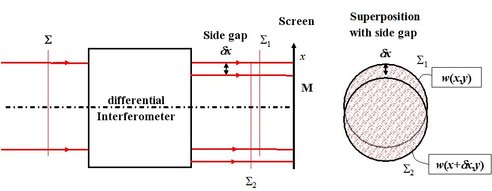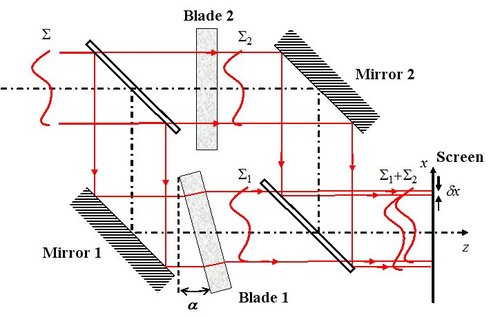
Differential Interferometers
Differential interferometers (also called lateral shift interferometers) are an often unknown component of interferometry but constitute an important field in various applications such as surfaces and optical system inspections or fluid and turbulences in gas and liquids studies.
The basic principle is to make interferences between the initial wavefront and its copy, laterally shifted of a small quantity [4]. Figure 20 illustrates the principle. We are used to laterally shift the wavefront not changing its shape and the optical components used in the interferometer are often semi-reflecting separator blades.

Let us write
 the wavefront in
the wavefront in
 in the screen plan. The laterally shifted front following
in the screen plan. The laterally shifted front following
 , for instance, of a quantity
, for instance, of a quantity
 is simply spelled
is simply spelled
 . The difference in an optical phase made by both wavefronts interferences is given by:
. The difference in an optical phase made by both wavefronts interferences is given by:
Because of the derivative mathematical definition, the difference of phase is also spelt
Thus, the information contained by the interferogram is relating to the wavefront derivative in the lateral shift direction; so it is linked to the wavefront slope in the shift direction.
Thus, the information contained by the interferogram is relating to the wavefront derivative in the lateral shift direction; so it is linked to the wavefront slope in the shift direction. Various experimental architectures exist to make a lateral shift interferometer [4]. A simple way is to use a Mach-Zehnder type interferometer in which we have had two parallel and plane sides glass blades each one inserted into one of the interferometer arm. If two blades are perfectly parallel, then both wavefronts are released perfectly superimposed from the interferometer and we can observe a pale tone as the difference of phase is nil. On the contrary, if we tilt blade no 1, for example, of an angle
 , wavefront no 1 is laterally shifted of
, wavefront no 1 is laterally shifted of
 after blade crossing. Thus, both wavefronts interfere in a differential mode. Quantity
after blade crossing. Thus, both wavefronts interfere in a differential mode. Quantity
 can be adjustable in function of the blade tilting angle. Indeed, for small angles, the lateral shift is given by:
can be adjustable in function of the blade tilting angle. Indeed, for small angles, the lateral shift is given by:

Other experimental solutions exist to make a differential interferometer. For further information, the reader should study reference [4].